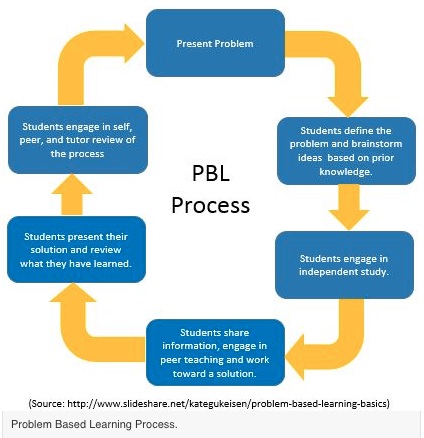Problem-Based Learning: What It Is And 5 Examples Of Learning Activities
26th July 2024
Solving problems is a life skill that is not limited to the classroom. The finest education is one that fosters critical and strategic thinking, equips students to face obstacles in life head-on, and gives them the self-assurance to figure out a solution.
Problem-based learning is an active learning approach that helps students become more realistically prepared for the real world by pushing them to think strategically and come up with workable answers. This is all the information you need to know about Problem-Based Learning, along with five motivating examples of problem-based learning.
What Is Problem-Based Learning?
PBL, or problem-based learning, is an inquiry-based teaching approach that helps students learn by utilizing challenging, real-world issues. This is in contrast to certain conventional teaching approaches when educators directly impart knowledge and ideas to their students.

Source: structural-learning.com
Using PBL for a whole semester or school year by a teacher would be the tightest implementation of the approach. In actuality, teachers employ it in several ways. It could be especially helpful in laboratory settings or for design tasks. It can also be employed to start conversations.
PBL may be applied when students are working in groups and helps them strengthen their communication, critical thinking, and problem-solving abilities.
Do you follow us on Social Media? If not, then you’re missing out on a lot of informative content. We regularly share upgraded educational content, tips, feedback, and more. Check us out by clicking the profiles here – Facebook / Twitter / LinkedIn / Pinterest / Instagram / YouTube
What Are The Examples Of Problem-Based Learning?
Let's take a look at some instances of problem-based learning that might serve as models for educators as they create new challenges to engage and instruct their pupils:
1. Organize A Road Trip
If students have taken family vacations, they may already have some familiarity with the real-world difficulty of road trip planning. A road trip can be used as a PBL project to integrate many subjects, such as arithmetic, geography, social sciences, and environmental sciences.
Every element of the trip should be planned by the students, including the route to be followed, the stops to be made along the way, the costs, and the amount of gasoline to be used.
2. Establish Sustainability
The question of how to live sustainably and prevent depleting our natural resources is among the most urgent real-world issues that one might conceive.
Students can collaborate to consider the sustainability-related issues that cities confront and come up with solutions by drawing on their own experiences and studies.
3. Craft A Voyage
Students can explore a range of disciplines, such as geography, global culture, social studies, and even velocity and floatation, through the obstacles presented by a global trip.
Before presenting their findings, students should think about the weather, time constraints, forms of transportation, and other factors.
4. Plan A Zoo Habitat
Students can start their PBL project by going to the zoo, where they can see animals in their natural habitats and ask zookeepers questions about what it's like to take care of the creatures there.
Next, using biology and environmental science, students should choose an animal, think about its natural habitat and diet, and design a home for it.
5. Codebreak Math Equations
In this project-based learning scenario, students take on the role of expert codebreakers rather than solving standard equations.
They will decode a code and create a response using a code of their own by applying logic, critical thinking, and math.
What Are The Steps Involved In Problem-Based Learning?
These procedures should be followed by educators who want to use problem-based learning in the classroom to formulate an issue and present it to the class:
- Opt For A Central Concept
Choosing a key idea or principle that you want your pupils to acquire is the first step. The idea picked needs to be frequently covered in that particular course. To aid students in understanding the material, the issue should resemble one that is usually given after a chapter.
Following the selection of a primary idea, the instructor should create a set of learning objectives for the students to fulfill as they investigate the issue and ascertain the most effective course of action.
- Think O A Real World Problem
At this point, educators must create a realistic setting that will enable students to navigate the issue and make use of the necessary resources to come up with a solution.
Ideas for real-world issues may be found in magazines, newspapers, articles, TV news, and by speaking with experts on the subject.
- Introduce Problem In Stages
Present the subject gradually so that students may discover areas of difficulty in their learning and be motivated to study more about the concepts being covered.
By posing these queries, educators may create logical steps that lead students toward solving problems.
- Write A Teachers Guide
The instructor has to create a manual with thorough lesson plans that address the issue. Plans to cycle through the problem utilizing several learning modalities should be outlined in the guide. It could contain other choices.
To guarantee that every student gets the assistance they require, every topic covered in a large class may involve a mix of mini-lectures, small group work, and whole class discussions.
Encourage Learners To Innovate
Using PBL in the classroom provides educators with a dynamic framework to support students' learning. Teachers who are equipped with Live Online International Teaching Diploma Course enable students to stay engaged in their homework while innovating leading to better outcomes and increased student accomplishment.
We believe education should be accessible for everyone. That’s why we don’t charge for our blogs. Find the right course that will help you in your career with us, contact us at - 1800–212–6400. You can mail us at act@asiancollegeofteachers.com.
Written By : Sanjana
Leave a Reply

